VBA stands for Visual Basic for Applications an
event-driven programming language from Microsoft that is now
predominantly used with Microsoft office applications such as MSExcel,
MS-Word, and MS-Access.
It helps techies to build customized applications and solutions to enhance the capabilities of those applications.
The advantage of this facility is that you NEED NOT have visual basic installed on our PC, however, installing Office will implicitly help in achieving the purpose.
You can use VBA in all office versions, right from MS-Office 97 to MS-Office 2013 and also with any of the latest versions available. Among VBA, Excel VBA is the most popular. The advantage of using VBA is that you can build very powerful tools in MS Excel using linear programming.
For example, it is very hard to calculate the monthly repayment of a loan using Excel's built-in formulas. Rather, it is easy to program a VBA for such a calculation.
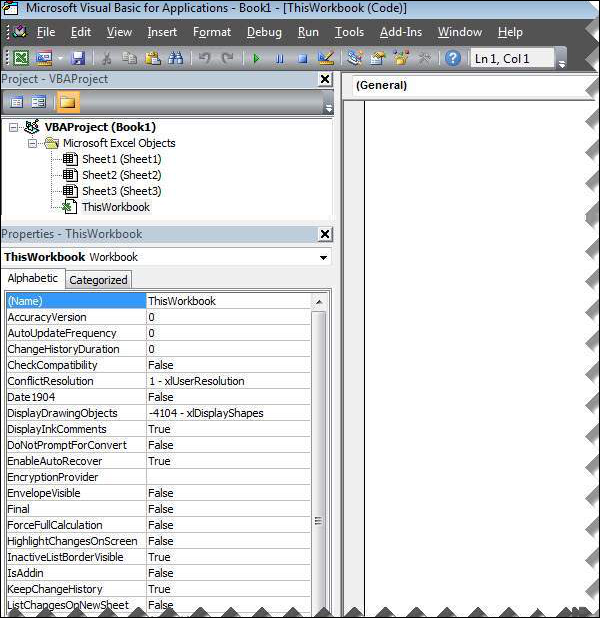
Step 1 − First, enable 'Developer' menu in Excel 20XX. To do the same, click File → Options.
Step 2 − Click ‘Customize the Ribbon’ tab and check 'Developer'. Click 'OK'.
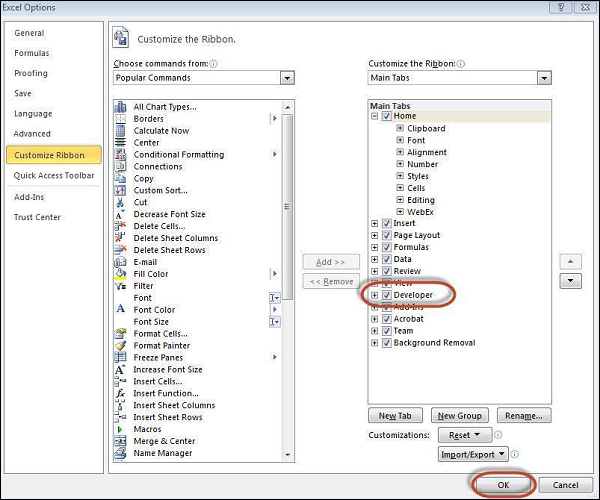 Step 3 − The 'Developer' ribbon appears in the menu bar.
Step 3 − The 'Developer' ribbon appears in the menu bar.
 Step 4 − Click the 'Visual Basic' button to open the VBA Editor.
Step 4 − Click the 'Visual Basic' button to open the VBA Editor.
 Step 5 − Start scripting by adding a button. Click Insert → Select the button.
Step 5 − Start scripting by adding a button. Click Insert → Select the button.
 Step 6 − Perform a right-click and choose 'properties'.
Step 6 − Perform a right-click and choose 'properties'.
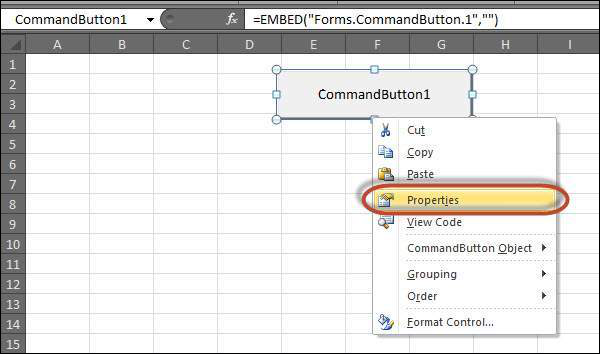 Step 7 − Edit the name and caption as shown in the following screenshot.
Step 7 − Edit the name and caption as shown in the following screenshot.
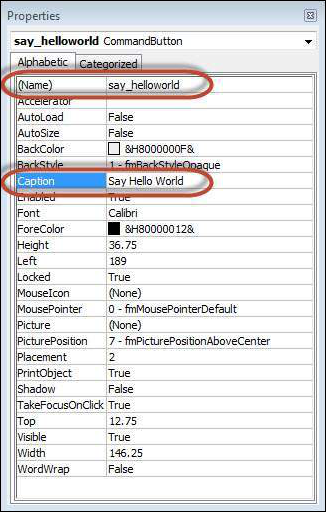 Step 8 − Now double-click the button and the sub-procedure outline will be displayed as shown in the following screenshot.
Step 8 − Now double-click the button and the sub-procedure outline will be displayed as shown in the following screenshot.
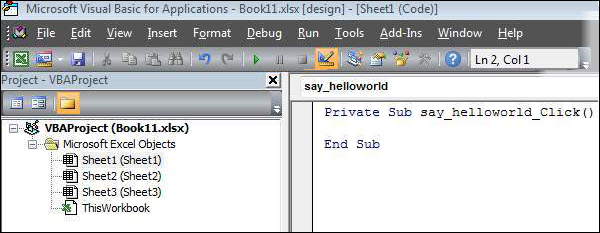 Step 9 − Start coding by simply adding a message.
Step 9 − Start coding by simply adding a message.
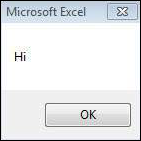 Note − In further chapters, we will demonstrate using a simple
button, as explained from step#1 to 10. Hence , it is important to
understand this chapter thoroughly.
Note − In further chapters, we will demonstrate using a simple
button, as explained from step#1 to 10. Hence , it is important to
understand this chapter thoroughly.
 To insert a Module, navigate to Insert → Module. Once a module is inserted 'module1' is created.
To insert a Module, navigate to Insert → Module. Once a module is inserted 'module1' is created.
Within the modules, we can write VBA code and the code is written within a Procedure. A Procedure/Sub Procedure is a series of VBA statements instructing what to do.
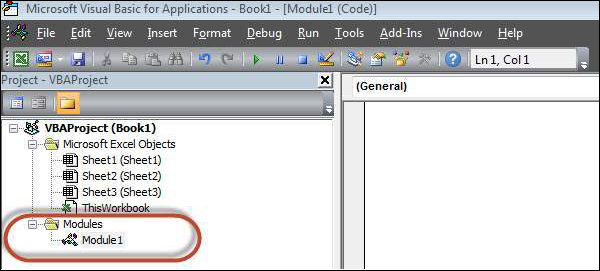
The two main types of Procedures are Sub and Function.
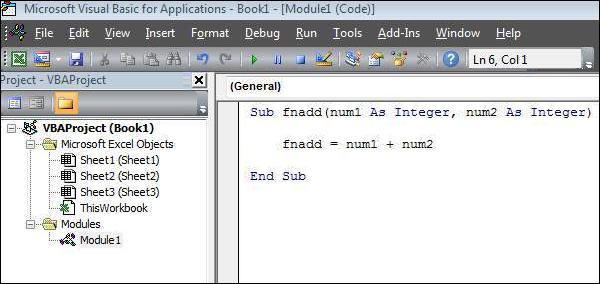
Apart from inbuilt Functions, VBA allows to write user-defined functions as well and statements are written between Function and End Function.
It includes information such as developed by, modified by, and can also include incorporated logic. Comments are ignored by the interpreter while execution.
Comments in VBA are denoted by two methods.
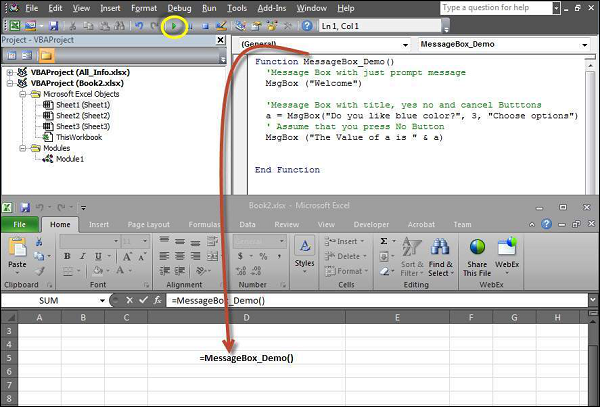 Step 2 − A Simple Message box is displayed with a message "Welcome" and an "OK" Button
Step 2 − A Simple Message box is displayed with a message "Welcome" and an "OK" Button
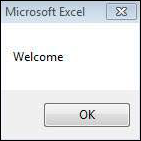 Step 3 − After Clicking OK, yet another dialog box is displayed with a message along with "yes, no, and cancel" buttons.
Step 3 − After Clicking OK, yet another dialog box is displayed with a message along with "yes, no, and cancel" buttons.
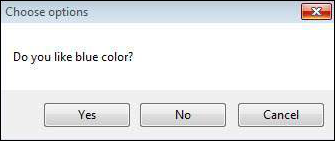 Step 4 − After clicking the ‘No’ button, the value of that
button (7) is stored as an integer and displayed as a message box to the
user as shown in the following screenshot. Using this value, it can be
understood which button the user has clicked.
Step 4 − After clicking the ‘No’ button, the value of that
button (7) is stored as an integer and displayed as a message box to the
user as shown in the following screenshot. Using this value, it can be
understood which button the user has clicked.
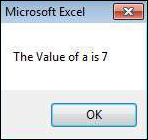
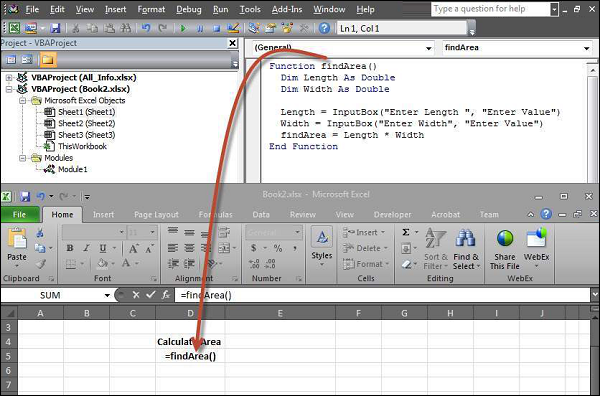 Step 2 − Upon execution, the First input box (length) is displayed. Enter a value into the input box.
Step 2 − Upon execution, the First input box (length) is displayed. Enter a value into the input box.
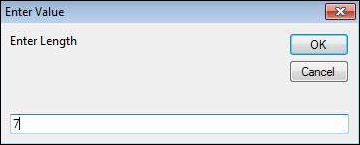 Step 3 − After entering the first value, the second input box (width) is displayed.
Step 3 − After entering the first value, the second input box (width) is displayed.
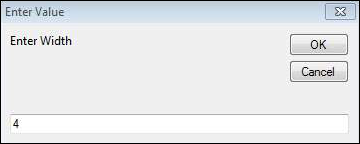 Step 4 − Upon entering the second number, click the OK button. The area is displayed as shown in the following screenshot.
Step 4 − Upon entering the second number, click the OK button. The area is displayed as shown in the following screenshot.

It helps techies to build customized applications and solutions to enhance the capabilities of those applications.
The advantage of this facility is that you NEED NOT have visual basic installed on our PC, however, installing Office will implicitly help in achieving the purpose.
You can use VBA in all office versions, right from MS-Office 97 to MS-Office 2013 and also with any of the latest versions available. Among VBA, Excel VBA is the most popular. The advantage of using VBA is that you can build very powerful tools in MS Excel using linear programming.
Application of VBA
You might wonder why to use VBA in Excel as MS-Excel itself provides loads of inbuilt functions. MS-Excel provides only basic inbuilt functions which might not be sufficient to perform complex calculations. Under such circumstances, VBA becomes the most obvious solution.For example, it is very hard to calculate the monthly repayment of a loan using Excel's built-in formulas. Rather, it is easy to program a VBA for such a calculation.
Accessing VBA Editor
In Excel window, press "ALT+F11". A VBA window opens up as shown in the following screenshot.
VBA - Excel Macros
In this chapter, you will learn how to write a simple macro in a step by step manner.Step 1 − First, enable 'Developer' menu in Excel 20XX. To do the same, click File → Options.
Step 2 − Click ‘Customize the Ribbon’ tab and check 'Developer'. Click 'OK'.
 Step 3 − The 'Developer' ribbon appears in the menu bar.
Step 3 − The 'Developer' ribbon appears in the menu bar. Step 4 − Click the 'Visual Basic' button to open the VBA Editor.
Step 4 − Click the 'Visual Basic' button to open the VBA Editor. Step 5 − Start scripting by adding a button. Click Insert → Select the button.
Step 5 − Start scripting by adding a button. Click Insert → Select the button. Step 6 − Perform a right-click and choose 'properties'.
Step 6 − Perform a right-click and choose 'properties'. Step 7 − Edit the name and caption as shown in the following screenshot.
Step 7 − Edit the name and caption as shown in the following screenshot. Step 8 − Now double-click the button and the sub-procedure outline will be displayed as shown in the following screenshot.
Step 8 − Now double-click the button and the sub-procedure outline will be displayed as shown in the following screenshot. Step 9 − Start coding by simply adding a message.
Step 9 − Start coding by simply adding a message.Private Sub say_helloworld_Click() MsgBox "Hi" End SubStep 10 − Click the button to execute the sub-procedure. The output of the sub-procedure is shown in the following screenshot.
 Note − In further chapters, we will demonstrate using a simple
button, as explained from step#1 to 10. Hence , it is important to
understand this chapter thoroughly.
Note − In further chapters, we will demonstrate using a simple
button, as explained from step#1 to 10. Hence , it is important to
understand this chapter thoroughly.VBA - Excel Terms
In this chapter, you will acquaint yourself with the commonly used excel VBA terminologies. These terminologies will be used in further modules, hence understanding each one of these is important.Modules
Modules is the area where the code is written. This is a new Workbook, hence there aren't any Modules. To insert a Module, navigate to Insert → Module. Once a module is inserted 'module1' is created.
To insert a Module, navigate to Insert → Module. Once a module is inserted 'module1' is created.Within the modules, we can write VBA code and the code is written within a Procedure. A Procedure/Sub Procedure is a series of VBA statements instructing what to do.

Procedure
Procedures are a group of statements executed as a whole, which instructs Excel how to perform a specific task. The task performed can be a very simple or a very complicated task. However, it is a good practice to break down complicated procedures into smaller ones.The two main types of Procedures are Sub and Function.

Function
A function is a group of reusable code, which can be called anywhere in your program. This eliminates the need of writing the same code over and over again. This helps the programmers to divide a big program into a number of small and manageable functions.Apart from inbuilt Functions, VBA allows to write user-defined functions as well and statements are written between Function and End Function.
Sub-Procedures
Sub-procedures work similar to functions. While sub procedures DO NOT Return a value, functions may or may not return a value. Sub procedures CAN be called without call keyword. Sub procedures are always enclosed within Sub and End Sub statements.VBA - Macro Comments
Comments are used to document the program logic and the user information with which other programmers can seamlessly work on the same code in future.It includes information such as developed by, modified by, and can also include incorporated logic. Comments are ignored by the interpreter while execution.
Comments in VBA are denoted by two methods.
- Any statement that starts with a Single Quote (') is treated as comment. Following is an example.
' This Script is invoked after successful login ' Written by : TutorialsPoint ' Return Value : True / False
- Any statement that starts with the keyword "REM". Following is an example.
REM This Script is written to Validate the Entered Input REM Modified by : Tutorials point/user2
VBA - Message Box
The MsgBox function displays a message box and waits for the user to click a button and then an action is performed based on the button clicked by the user.Syntax
MsgBox(prompt[,buttons][,title][,helpfile,context])
Parameter Description
- Prompt − A Required Parameter. A String that is displayed as a message in the dialog box. The maximum length of prompt is approximately 1024 characters. If the message extends to more than a line, then the lines can be separated using a carriage return character (Chr(13)) or a linefeed character (Chr(10)) between each line.
- Buttons − An Optional Parameter. A Numeric expression that specifies the type of buttons to display, the icon style to use, the identity of the default button, and the modality of the message box. If left blank, the default value for buttons is 0.
- Title − An Optional Parameter. A String expression displayed in the title bar of the dialog box. If the title is left blank, the application name is placed in the title bar.
- Helpfile − An Optional Parameter. A String expression that identifies the Help file to use for providing context-sensitive help for the dialog box.
- Context − An Optional Parameter. A Numeric expression that identifies the Help context number assigned by the Help author to the appropriate Help topic. If context is provided, helpfile must also be provided.
- 0 vbOKOnly - Displays OK button only.
- 1 vbOKCancel - Displays OK and Cancel buttons.
- 2 vbAbortRetryIgnore - Displays Abort, Retry, and Ignore buttons.
- 3 vbYesNoCancel - Displays Yes, No, and Cancel buttons.
- 4 vbYesNo - Displays Yes and No buttons.
- 5 vbRetryCancel - Displays Retry and Cancel buttons.
- 16 vbCritical - Displays Critical Message icon.
- 32 vbQuestion - Displays Warning Query icon.
- 48 vbExclamation - Displays Warning Message icon.
- 64 vbInformation - Displays Information Message icon.
- 0 vbDefaultButton1 - First button is default.
- 256 vbDefaultButton2 - Second button is default.
- 512 vbDefaultButton3 - Third button is default.
- 768 vbDefaultButton4 - Fourth button is default.
- 0 vbApplicationModal Application modal - The current application will not work until the user responds to the message box.
- 4096 vbSystemModal System modal - All applications will not work until the user responds to the message box.
Return Values
The MsgBox function can return one of the following values which can be used to identify the button the user has clicked in the message box.- 1 - vbOK - OK was clicked
- 2 - vbCancel - Cancel was clicked
- 3 - vbAbort - Abort was clicked
- 4 - vbRetry - Retry was clicked
- 5 - vbIgnore - Ignore was clicked
- 6 - vbYes - Yes was clicked
- 7 - vbNo - No was clicked
Example
Function MessageBox_Demo() 'Message Box with just prompt message MsgBox("Welcome") 'Message Box with title, yes no and cancel Butttons a = MsgBox("Do you like blue color?",3,"Choose options") ' Assume that you press No Button msgbox ("The Value of a is " & a) End Function
Output
Step 1 − The above Function can be executed either by clicking the "Run" button on VBA Window or by calling the function from Excel Worksheet as shown in the following screenshot. Step 2 − A Simple Message box is displayed with a message "Welcome" and an "OK" Button
Step 2 − A Simple Message box is displayed with a message "Welcome" and an "OK" Button Step 3 − After Clicking OK, yet another dialog box is displayed with a message along with "yes, no, and cancel" buttons.
Step 3 − After Clicking OK, yet another dialog box is displayed with a message along with "yes, no, and cancel" buttons. Step 4 − After clicking the ‘No’ button, the value of that
button (7) is stored as an integer and displayed as a message box to the
user as shown in the following screenshot. Using this value, it can be
understood which button the user has clicked.
Step 4 − After clicking the ‘No’ button, the value of that
button (7) is stored as an integer and displayed as a message box to the
user as shown in the following screenshot. Using this value, it can be
understood which button the user has clicked.
VBA - InputBox
The InputBox function prompts the users to enter values. After entering the values, if the user clicks the OK button or presses ENTER on the keyboard, the InputBox function will return the text in the text box. If the user clicks the Cancel button, the function will return an empty string ("").Syntax
InputBox(prompt[,title][,default][,xpos][,ypos][,helpfile,context])
Parameter Description
- Prompt − A required parameter. A String that is displayed as a message in the dialog box. The maximum length of prompt is approximately 1024 characters. If the message extends to more than a line, then the lines can be separated using a carriage return character (Chr(13)) or a linefeed character (Chr(10)) between each line.
- Title − An optional parameter. A String expression displayed in the title bar of the dialog box. If the title is left blank, the application name is placed in the title bar.
- Default − An optional parameter. A default text in the text box that the user would like to be displayed.
- XPos − An optional parameter. The position of X axis represents the prompt distance from the left side of the screen horizontally. If left blank, the input box is horizontally centered.
- YPos − An optional parameter. The position of Y axis represents the prompt distance from the left side of the screen vertically. If left blank, the input box is vertically centered.
- Helpfile − An optional parameter. A String expression that identifies the helpfile to be used to provide context-sensitive Help for the dialog box.
- context − An optional parameter. A Numeric expression that identifies the Help context number assigned by the Help author to the appropriate Help topic. If context is provided, helpfile must also be provided.
Example
Let us calculate the area of a rectangle by getting values from the user at run time with the help of two input boxes (one for length and one for width).Function findArea() Dim Length As Double Dim Width As Double Length = InputBox("Enter Length ", "Enter a Number") Width = InputBox("Enter Width", "Enter a Number") findArea = Length * Width End Function
Output
Step 1 − To execute the same, call using the function name and press Enter as shown in the following screenshot. Step 2 − Upon execution, the First input box (length) is displayed. Enter a value into the input box.
Step 2 − Upon execution, the First input box (length) is displayed. Enter a value into the input box. Step 3 − After entering the first value, the second input box (width) is displayed.
Step 3 − After entering the first value, the second input box (width) is displayed. Step 4 − Upon entering the second number, click the OK button. The area is displayed as shown in the following screenshot.
Step 4 − Upon entering the second number, click the OK button. The area is displayed as shown in the following screenshot.

No comments:
Post a Comment